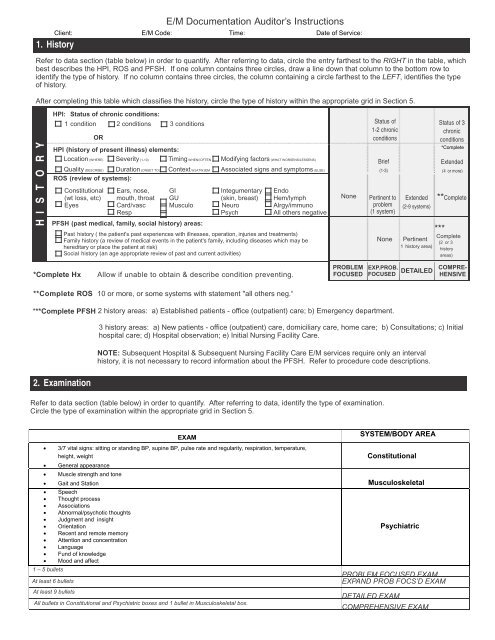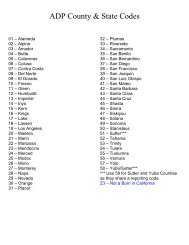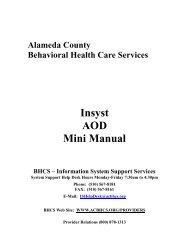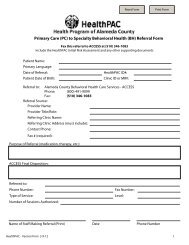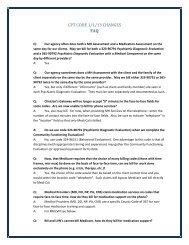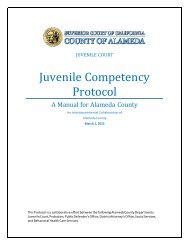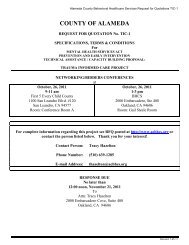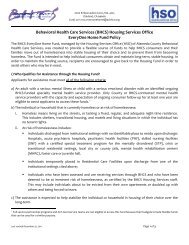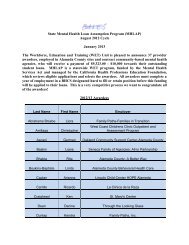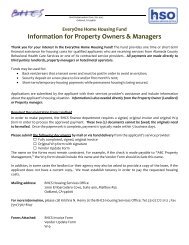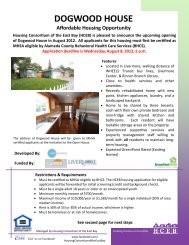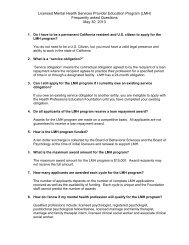E/M Documentation Based on the Elements: Auditing Tool
E/M Documentation Based on the Elements: Auditing Tool
E/M Documentation Based on the Elements: Auditing Tool
You also want an ePaper? Increase the reach of your titles
YUMPU automatically turns print PDFs into web optimized ePapers that Google loves.
E/M <str<strong>on</strong>g>Documentati<strong>on</strong></str<strong>on</strong>g> Auditor’s Instructi<strong>on</strong>sClient: E/M Code: Time: Date of Service:1. HistoryRefer to data secti<strong>on</strong> (table below) in order to quantify. After referring to data, circle <strong>the</strong> entry far<strong>the</strong>st to <strong>the</strong> RIGHT in <strong>the</strong> table, whichbest describes <strong>the</strong> HPI, ROS and PFSH. If <strong>on</strong>e column c<strong>on</strong>tains three circles, draw a line down that column to <strong>the</strong> bottom row toidentify <strong>the</strong> type of history. If no column c<strong>on</strong>tains three circles, <strong>the</strong> column c<strong>on</strong>taining a circle far<strong>the</strong>st to <strong>the</strong> LEFT, identifies <strong>the</strong> typeof history.After completing this table which classifies <strong>the</strong> history, circle <strong>the</strong> type of history within <strong>the</strong> appropriate grid in Secti<strong>on</strong> 5.H I S T O R YHPI: Status of chr<strong>on</strong>ic c<strong>on</strong>diti<strong>on</strong>s:1 c<strong>on</strong>diti<strong>on</strong> 2 c<strong>on</strong>diti<strong>on</strong>s 3 c<strong>on</strong>diti<strong>on</strong>sORHPI (history of present illness) elements:Locati<strong>on</strong> (WHERE) Severity (1-10) Timing WHEN//OFTEN Modifying factors (WHAT WORSENS/LESSENS)Quality (DESCRIBE) Durati<strong>on</strong> (ONSET TO) C<strong>on</strong>text WJATWJEM Associated signs and symptoms (ELSE)ROS (review of systems):C<strong>on</strong>stituti<strong>on</strong>al Ears, nose, GI Integumentary Endo(wt loss, etc) mouth, throat GU (skin, breast) Hem/lymphEyes Card/vasc Musculo Neuro Alrgy/immunoResp Psych All o<strong>the</strong>rs negativePFSH (past medical, family, social history) areas:Past history ( <strong>the</strong> patient's past experiences with illnesses, operati<strong>on</strong>, injuries and treatments)Family history (a review of medical events in <strong>the</strong> patient's family, including diseases which may behereditary or place <strong>the</strong> patient at risk)Social history (an age appropriate review of past and current activities)N<strong>on</strong>eStatus of1-2 chr<strong>on</strong>icc<strong>on</strong>diti<strong>on</strong>sBrief(1-3)Pertinent toproblem(1 system)N<strong>on</strong>eExtended(2-9 systems)Pertinent1 history area)Status of 3chr<strong>on</strong>icc<strong>on</strong>diti<strong>on</strong>s*CompleteExtended(4 or more)**Complete***Complete(2 or 3historyareas)*Complete HxAllow if unable to obtain & describe c<strong>on</strong>diti<strong>on</strong> preventing.PROBLEMFOCUSED EXP.PROB.FOCUSED DETAILEDCOMPRE-HENSIVE**Complete ROS 10 or more, or some systems with statement "all o<strong>the</strong>rs neg.“***Complete PFSH 2 history areas: a) Established patients - office (outpatient) care; b) Emergency department.2. Examinati<strong>on</strong>3 history areas: a) New patients - office (outpatient) care, domiciliary care, home care; b) C<strong>on</strong>sultati<strong>on</strong>s; c) Initialhospital care; d) Hospital observati<strong>on</strong>; e) Initial Nursing Facility Care.NOTE: Subsequent Hospital & Subsequent Nursing Facility Care E/M services require <strong>on</strong>ly an intervalhistory, it is not necessary to record informati<strong>on</strong> about <strong>the</strong> PFSH. Refer to procedure code descripti<strong>on</strong>s.Refer to data secti<strong>on</strong> (table below) in order to quantify. After referring to data, identify <strong>the</strong> type of examinati<strong>on</strong>.Circle <strong>the</strong> type of examinati<strong>on</strong> within <strong>the</strong> appropriate grid in Secti<strong>on</strong> 5.EXAMSYSTEM/BODY AREA 3/7 vital signs: sitting or standing BP, supine BP, pulse rate and regularity, respirati<strong>on</strong>, temperature,height, weightC<strong>on</strong>stituti<strong>on</strong>al General appearance Muscle strength and t<strong>on</strong>e Gait and Stati<strong>on</strong> Musculoskeletal Speech Thought process Associati<strong>on</strong>s Abnormal/psychotic thoughts Judgment and insight Orientati<strong>on</strong> Recent and remote memory Attenti<strong>on</strong> and c<strong>on</strong>centrati<strong>on</strong> Language Fund of knowledge Mood and affect1 – 5 bulletsAt least 6 bulletsAt least 9 bulletsAll bullets in C<strong>on</strong>stituti<strong>on</strong>al and Psychiatric boxes and 1 bullet in Musculoskeletal box.PsychiatricPROBLEM FOCUSED EXAMEXPAND PROB FOCS’D EXAMDETAILED EXAMCOMPREHENSIVE EXAM
3. Medical Decisi<strong>on</strong> MakingNumber of Diagnoses or Treatment Opti<strong>on</strong>sIdentify each problem or treatment opti<strong>on</strong> menti<strong>on</strong>ed in <strong>the</strong> record.Enter <strong>the</strong> number in each of <strong>the</strong> categories in Column B in <strong>the</strong> tablebelow. (There are maximum number in two categories.) Do notcategorize <strong>the</strong> problem(s) if <strong>the</strong> encounter is dominated bycounseling/coordinating of care, and durati<strong>on</strong> of time is not specified.In that case, enter 3 in <strong>the</strong> total box.M E D I C A L D E C I S I O N M A K INumber of Diagnoses or Treatment Opti<strong>on</strong>sA B X C = DProblem(s) StatusNumber Points ResultSelf-limited or minor(stable, improved or worsening)Max = 2 1Est. problem (to examiner); stable, improved 1Est. problem (to examiner); worsening 2New problem (to examiner); no additi<strong>on</strong>al3workup plannedMax = 1New prob. (to examiner); add. workup planned 4TOTALMultiply <strong>the</strong> number in columns B & C and put <strong>the</strong> product in column D.Enter a total for column D.Bring total to line A in Final Result for Complexity (table below)Amount and/or Complexity of Data ReviewedFor each category of reviewed data identified, circle <strong>the</strong> number in<strong>the</strong> points column. Total <strong>the</strong> points.Amount and/or Complexity of Data ReviewedReviewed DataPointsReview and/or order of clinical lab tests 1Review and/or order of tests in <strong>the</strong> radiology secti<strong>on</strong> of CPT 1Review and/or order of tests in <strong>the</strong> medicine secti<strong>on</strong> of CPT 1Discussi<strong>on</strong> of test results with performing physician 1Decisi<strong>on</strong> to obtain old records and/or obtain history fromsome<strong>on</strong>e o<strong>the</strong>r than patientReview and summarizati<strong>on</strong> of old records and/or obtaininghistory from some<strong>on</strong>e o<strong>the</strong>r than patient and/or discussi<strong>on</strong> ofcase with ano<strong>the</strong>r health care providerIndependent visualizati<strong>on</strong> of image, tracing or specimen itself(not simply review of report) 2TOTALBring total to line C in Final Result for Complexity (table below)Risk of Complicati<strong>on</strong>s and/or Morbidity or Mortality Use <strong>the</strong> risk table below as a guide to assign risk factors. It is understood that <strong>the</strong> table below does notc<strong>on</strong>tain all specific instances of medical care; <strong>the</strong> table is intended to be used as a guide. Circle <strong>the</strong> mostappropriate factor(s) in each category. The overall measure of risk is <strong>the</strong> highest level circled.Enter <strong>the</strong> level of risk identified in Final Result for Complexity (table below).Level ofRiskMinimalLowPresenting Problem(s)• One self-limited or minor problem• Two or more self-limited or minor problems• One stable chr<strong>on</strong>ic illness• Acute uncomplicated illnessDiagnostic Procedure(s)Ordered• Laboratory tests requiring venipuncture• EKG/EEG• Urinalysis• RestManagement Opti<strong>on</strong>sSelected• Over-<strong>the</strong>-counter drugs12ModerateHigh• One or more chr<strong>on</strong>ic illnesses with mildexacerbati<strong>on</strong>, progressi<strong>on</strong>, or side effects of treatment• Two or more stable chr<strong>on</strong>ic illnesses• Undiagnosed new problem with uncertain prognosis,• Acute illness with systemic symptoms• One or more chr<strong>on</strong>ic illnesses with severeexacerbati<strong>on</strong>, progressi<strong>on</strong>, or side effects of treatment• Acute or chr<strong>on</strong>ic illnesses or injuries that may pose a threat tolife or bodily functi<strong>on</strong> (self//o<strong>the</strong>r)• Prescripti<strong>on</strong> drug management• Drug <strong>the</strong>rapy requiring intensive m<strong>on</strong>itoring for toxicityFinal Result for ComplexityDraw a line down any column with 2 or 3 circles to identify <strong>the</strong> type of decisi<strong>on</strong> makingin that column. O<strong>the</strong>rwise, draw a line down <strong>the</strong> column with <strong>the</strong> 2nd circle from <strong>the</strong> left.After completing this table, which classifies complexity, circle <strong>the</strong> type of decisi<strong>on</strong>making within <strong>the</strong> appropriate grid in Secti<strong>on</strong> 5.Final Result for Complexity≤ 1 2 3 ≥ 4A Number diagnoses orMinimal Limited Multiple Extensivetreatment opti<strong>on</strong>s4. TimeIf <strong>the</strong> physician documents total time and suggests that counseling or coordinating care dominates(more than 50%) <strong>the</strong> encounter, time may determine level of service. <str<strong>on</strong>g>Documentati<strong>on</strong></str<strong>on</strong>g> may refer to:prognosis, differential diagnosis, risks, benefits of treatment, instructi<strong>on</strong>s, compliance, riskreducti<strong>on</strong> or discussi<strong>on</strong> with ano<strong>the</strong>r health care provider.B Highest Risk Minimal Low Moderate HighCAmount and complexityof data≤ 1Minimalor lowType of decisi<strong>on</strong> makingSTRAIGHT-FORWARD2Limited3Multiple≥ 4ExtensiveLOW MODERATE HIGHCOMPLEX. COMPLEX. COMPLEX.Face-to-face in outpatient settingDoes documentati<strong>on</strong> reveal total time? Time: Unit/floor in inpatient setting Yes NoDoes documentati<strong>on</strong> describe <strong>the</strong> c<strong>on</strong>tent of counseling or coordinating care?Does documentati<strong>on</strong> reveal that more than half of <strong>the</strong> time was counselingor coordinating care?Yes NoIf all answers are "yes", select level based <strong>on</strong> time.5. L E V E L O F S E R V I C E5. New Office Established OfficeRequires 3 comp<strong>on</strong>ents within shaded areaRequires 2 comp<strong>on</strong>ents within shaded areaMinimalHistory P EPF D C CproblemPF EPF D Cthat mayExaminati<strong>on</strong> P EPF D C Cnot requirePF EPF D CfComplexity S SF L M H physicianSF L M HTimeCode10”9920120”9920230”9920345”9920460”992055”9921110”9921215”9921325”99214Yes40”99215No


